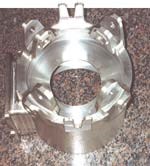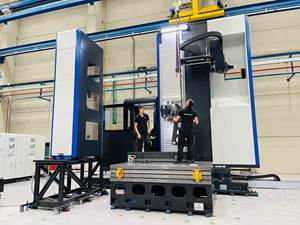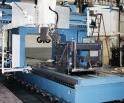New Contours Of Competition
Toronto aerospace shops improve productivity with faster five-axis machining centers.
Share



The rapid evolution of aircraft designs creates constant challenges for companies that manufacture aerospace components. Many airframe structures that formerly were composed of assembled components are now machined in single pieces from large aluminum billets. On the shop floor, this entails producing larger parts with more complex features.
Improving metal removal rates for particular machining operations is a goal pursued by every machine shop. This is especially true in the production of aerospace parts that typically require converting 70-80 percent of the original stock to chips. When hogging out a large volume of aluminum at slower speeds, substantial heat may be transferred to a workpiece. Under this heat stress, structural walls of honeycombed airframe parts and other thin features may be distorted.
For this reason, taking lighter cuts at higher spindle speeds represents as significant an advantage in milling soft aluminum as it does when milling hardened steels. But this advantage can't be fully exploited without machine tools specifically designed to rapidly negotiate the complex contours of airframe parts. While aerospace shops have been machining such parts for many years, their work isn't always performed with five-axis machines.
With the machine tool technology available today, however, the trade-offs necessary to perform five-axis work with three- or four-axis equipment can place a shop at a competitive disadvantage. For example, conventional, three-axis machines may require multiple setups or complicated fixturing to machine complex parts. Additionally, a three-axis machining center that uses a tilting rotary table for five-axis work may be quite limited with regard to the size and weight of workpieces that it can accept.
A Tale of Two Shops
In metropolitan Toronto, two machine shops compete aggressively to supply precision aerospace parts for clients such as Boeing and Bombardier. Established in 1967, MBM Tool & Machine Co. Ltd. (Woodbridge, Ontario) occupies a 60,000 square foot manufacturing facility equipped with an impressive array of machine tools. This equipment includes 37 CNC machining centers, seven CNC turning centers, 30 conventional milling and boring machines and nine grinding machines. MBM specializes in manufacturing structural, hydraulic and undercarriage components/assemblies for various aerospace applications. This includes parts for large commercial aircraft, regional aircraft, helicopters, space vehicles and the current multinational space station project.
Although MBM has been performing five-axis machining since 1982, the shop acquired its first high speed five-axis machine approximately 3 years ago. Vice president Boris Kikely and plant facilities manager Nick Ciccone had some compelling reasons for expanding their shop's capabilities. "Our decision was driven primarily by our customers' requirements," says Mr. Ciccone. "At that time, we were doing a lot of five-axis jobs on three- and four-axis machines. Using that process, our time consumption was too great, and as a result, we weren't as competitive as we needed to be."
The shop's clients constantly demand larger and more complex parts that incorporate many delicate features. For this reason, MBM needed to improve the efficiency of its machining process while maintaining an adequate work envelope capacity. To meet
this challenge, Mr. Kikely purchased a Vortex 1400/160 vertical, bridge-type, five-axis machining center manufactured by Mazak Corporation (Florence, Kentucky). This machine incorporates a 10,000-rpm spindle, a 60-tool ATC and a maximum work envelope of approximately 5 by 13 feet. It's operated by a Fanuc 15i CNC.
MBM also has three 5-axis machines with smaller work envelopes, including a Mazak HV630 horizontal/vertical machining center and two DMU eVolution high speed (18,000 rpm), universal milling machines manufactured by DMG. By using a Palletech manufacturing cell system with eight pallets and tombstones, MBM also performs a substantial amount of lights-out work with its Mazak FH580 high speed, horizontal, four-axis machine.
Before MBM purchased the Vortex machine, the shop was performing five-axis jobs with an older three-axis, gantry-type machine equipped with three spindles. The tool paths necessary to machine contoured features on this equipment, however, require considerably more cycle time than a five-axis machine. Additionally, programming this machine for five-axis work is more time consuming.
Although the Vortex machine has only one spindle, it has reduced the shop's average machining time by approximately 15-20 percent. This is principally due to substantially better metal removal rates achieved at higher spindle speeds and feed rates. For example, whereas MBM formerly was cutting metal at approximately 100 ipm, its current rate has increased nearly fivefold (490 ipm).
Changing from three spindles to a single spindle provides another significant advantage. "When you have downtime on a three-spindle machine, it takes more time to restart production," says Mr. Ciccone. Therefore, just as high speed milling uses a lighter cut to remove more metal in the same time period, reducing the number of spindles also illustrates the less-is-more approach. Because faster setups and changeovers from one type of part to another are now possible, this strategy gives MBM greater flexibility. This is an important benefit because the shop machines prototypes in addition to original and replacement parts for a variety of manufacturers.
MBM's cross-town competitor, Cyclone Manufacturing Inc. (Mississauga, Ontario), manufactures precision specialty components and assemblies for the aerospace, nuclear and defense industries. Approximately 87 percent of the firm's business derives from commercial aerospace clients, with the balance consisting primarily of defense-related aerospace work. Because of the firm's strong growth in recent years, the size of its shop facility was increased in 1997 from 24,000 square feet to 60,000 square feet. Established in 1964, the firm currently employs 160 people, including approximately 112 in its production department.
Cyclone's machine tool inventory includes six 5-axis milling centers, 19 four-axis machining centers, one 3-axis machining center and three CNC lathes. In the five-axis category, the shop's most recent acquisitions were three Mazak MV-5X milling centers purchased in 2000. Each of these machines has a 50-hp, 10,000 rpm spindle with an XYZ travel range of 120 by 32 by 30 inches. To handle very large workpieces such as structural beams for the fuselages of commercial jets, Cyclone uses a V-30 gantry machine manufactured by Cincinnati Machine (Cincinnati, Ohio) with an Acramatic 950 five-axis control. This machine also has a 10,000-rpm spindle (100 hp) and an XYZ travel range of 480 by 84 by 24 inches.
After handling five-axis work with three- and four-axis machines for several years, Cyclone purchased its first five-axis milling centers in 1992 and 1994. But these machines were quite limited in spindle speed, power and work envelope. By adding the new Mazak machines, the shop doubled its capacity in all three of these parameters. At the same time, Cyclone reduced its average machining time per part by 50 percent. "We saw the results immediately," says Cyclone's president Andrew Sochaj. "From only one machine, we were removing a 5,000-pound container of chips every 24 hours." Reflecting this leap in production speed, Cyclone also doubled its sales volume during the period from October 2000 to March 2001.
Mr. Sochaj was an early booster of the efficiencies of faster speeds and feeds for aluminum milling. When he originally became a Cyclone employee in 1978, Mr. Sochaj found that he could cut aluminum as fast as the capability of his machine permitted. Although his supervisors initially feared that Mr. Sochaj might be pressing the machine tools' mechanical limits, his aggressive approach combined with his education in CNC programming ultimately earned him the position as Cyclone's chief executive officer.
In Mr. Sochaj's view, reducing the number of operations required to produce finished parts stands as the greatest benefit that his shop derives from upgrading its five-axis machines. In many cases, Cyclone has cut the number of operations formerly required to produce finished parts by 50 percent or more. This enables Cyclone to turn over more jobs in a given period of time and also increases the shop's productive capacity. While he handles a larger volume of work, Mr. Sochaj also reduces lead times for his customers.
Continuous Cutting
Because aluminum's receptivity to high speed machining seems boundless, the trend toward faster and larger five-axis machines undoubtedly will continue in the future. Although the important roles of three- and four-axis machines are certainly not diminished in aerospace manufacturing, optimizing a production process via the judicious application of higher speed, five-axis tools is becoming a necessity to compete in this industry. Recognizing this fact, members of a diverse group of aerospace contractors throughout North America have reached a common conclusion regarding the need to invest in innovative machine tool technologies.
The payoff for this investment is evident each time a thick aluminum slab is transformed—in only minutes—to the recognizable form of an airframe part. The speed and accuracy with which shops such as MBM and Cyclone are producing precision parts today was unknown only a decade ago. This serves as a window to the future where finished parts will be created at mind-boggling rates and production costs will be reduced to a fraction of their current levels. Now and in the future, this productivity chase represents both the promise and the challenge of the metalworking profession.
Related Content
Inside a CNC-Machined Gothic Monastery in Wyoming
An inside look into the Carmelite Monks of Wyoming, who are combining centuries-old Gothic architectural principles with modern CNC machining to build a monastery in the mountains of Wyoming.
Read More4 Commonly Misapplied CNC Features
Misapplication of these important CNC features will result in wasted time, wasted or duplicated effort and/or wasted material.
Read MoreControlling Extreme Cutting Conditions in Large-Part Machining
Newly patented technologies for controlling chatter and vibration during milling, turning and boring operations promise to drastically reduce production time and increase machining performance.
Read MoreBallbar Testing Benefits Low-Volume Manufacturing
Thanks to ballbar testing with a Renishaw QC20-W, the Autodesk Technology Centers now have more confidence in their machine tools.
Read MoreRead Next
Four Types Of Five-Axis Machining Centers
Different machines offer different approaches to rotary travel, and each design has its own strengths. Here's how they compare.
Read MoreOEM Tour Video: Lean Manufacturing for Measurement and Metrology
How can a facility that requires manual work for some long-standing parts be made more efficient? Join us as we look inside The L. S. Starrett Company’s headquarters in Athol, Massachusetts, and see how this long-established OEM is updating its processes.
Read More
































